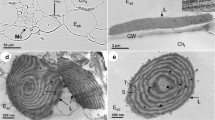Abstract
Contradictory concepts on whether the differentiation of plastids is monotropically directed or reversibly transformable with one another have been argued for a long time. In the present report, the evidence to support the latter concept, i.e. the reversible transformation, will be presented.
The seasonal yellowing and regreening ofEuonymus leaves were observed by means of electron microscopic study. In the yellowing of chloroplasts during winter, plastoglobules appeared in the plastid stroma and increased in number according to the disintegration of lamellae; then the degenerated chloroplasts (chromoplasts) were filled up with these plastoglobules. In the next spring, however, regreening of the yellowed leaves took place; the lamellae were regenerated in the chromoplasts to again restore the normal chloroplast structure. Infolding of the inner membrane was never observed in these regreening plastids. The number of plastoglobules in the plastids decreased as the lamellae regenerated, and the chlorophyll content increased. These observations suggest that the plastoglobules in chromoplasts (plastids in yellowed leaves) are made of material of the disintegrating lamellae and are re-used as the source of supply for the reformation of lamellae in the spring reversal.
Similar content being viewed by others
References
Chabot, J.F. andB.F. Chabot. 1974. Developmental and seasonal patterns of mesophyll ultrastructure inAbies balsamea. Can. J. Bot.53: 295–304.
Devidé, Z. andN. Ljubesić. 1974. The reversion of chromoplasts to chloroplasts in pumpkin fruits. Z. Pflanzenphysiol.73: 296–306.
Frey-Wyssling, A., F. Ruch andX. Berger. 1955. Monotrope Plastiden-Metamorphose. Protoplasma45: 97–114.
Ikeda, T. andR. Ueda. 1964. Light and electron microscope studies on the senescence of chloroplasts inElodea leaf cells. Bot. Mag. Tokyo77: 336–341.
Koski, V.M.. 1950. Chlorophyll formation in seedlings ofZea mays L. Arch. Biochem.29: 339–343.
Luft, J.H.. 1961. Improvements in epoxy resin embedding methods. J. Biophys. Biochem. Cytol.9: 409–414.
Schimper, A.F.W.. 1885. Untersuchungen über die Chlorophyllkörner und die ihnen homologen Gebilde. Jb. Wiss. Bot.16:1–247.
Thomson, W.W., L.N. Lewis andC.W. Coggins. 1967. The reversion of chromoplasts to chloroplasts in Valencia oranges. Cytologia32: 117–124.
Tôyama, S.. 1965. Electron microscope studies on the morphogenesis of plastids II. Changes in fine structure and pigment composition of the plastids in autumn leaves ofGinkgo biloba L. Sci. Rep. Tokyo Kyoiku Daigaku Sec. B.12: 31–37.
—. 1971. Electron microscope studies on the morphogenesis of plastids V. Concerning one-dimensional metamorphosis of the plastids inCryptomeria. Bot. Mag. Tokyo84: 123–136.
Author information
Authors and Affiliations
Rights and permissions
About this article
Cite this article
Ikeda, T. Electron microscopic evidence for the reversible transformation ofEuonymus plastids. Bot. Mag. Tokyo 92, 23–30 (1979). https://doi.org/10.1007/BF02488298
Received:
Issue Date:
DOI: https://doi.org/10.1007/BF02488298




